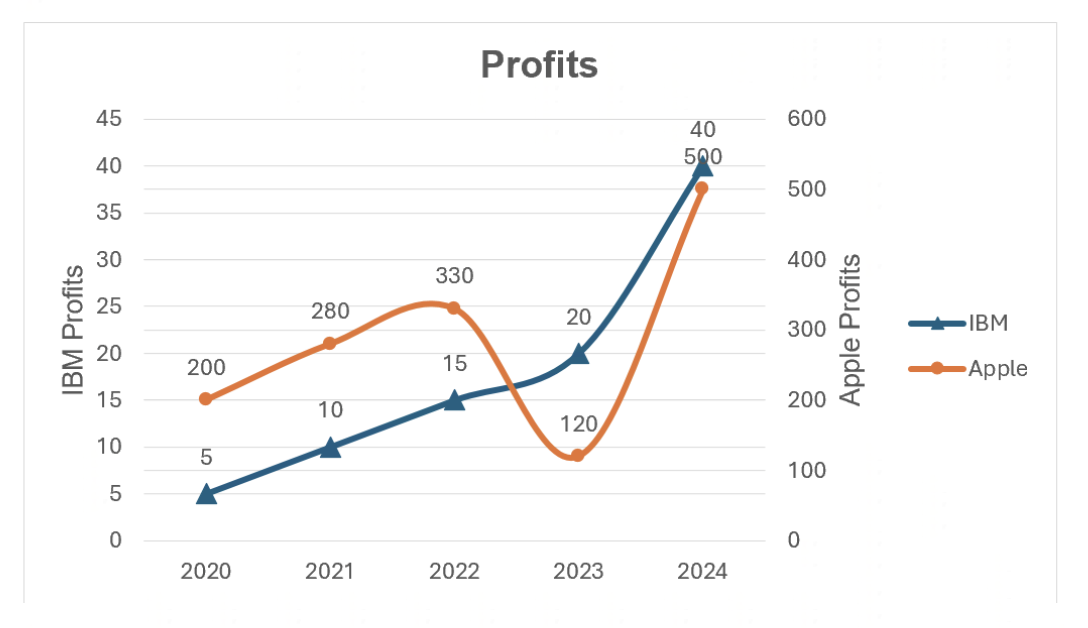'DeclarationPublic Class LineSeries Inherits Series
'UsageDim instance As LineSeries
public class LineSeries : Series
'DeclarationPublic Class LineSeries Inherits Series
'UsageDim instance As LineSeries
public class LineSeries : Series
The code below would display the following Chart:

var workbook = Workbook.Create( ChartSample.ChartSampleOutputDirectory + @"AddCharts.xlsx" ); // Gets the first Worksheet. A Workbook always contains at least 1 Worksheet. var worksheet = workbook.Worksheets[ 0 ]; // Adds Values for Category. worksheet.Cells[ "B4" ].Value = 2020; worksheet.Cells[ "B5" ].Value = 2021; worksheet.Cells[ "B6" ].Value = 2022; worksheet.Cells[ "B7" ].Value = 2023; worksheet.Cells[ "B8" ].Value = 2024; // Adds Values for Series. worksheet.Cells[ "C4" ].Value = 200; worksheet.Cells[ "C5" ].Value = 280; worksheet.Cells[ "C6" ].Value = 330; worksheet.Cells[ "C7" ].Value = 120; worksheet.Cells[ "C8" ].Value = 500; // Adds a LineChart with the generic Add method and set its SubType. The size of the Chart will be from Cell E4 to L18. var lineChart = worksheet.Charts.Add<LineChart>( "E4", "L18" ); lineChart.SubType = LineChartSubType.LineWithMarkers; // Sets the Chart's Title. lineChart.Title.Text = "Profits"; lineChart.Title.TextOptions.Font.Bold = true; // Sets the Legend. lineChart.Legend.Position = LegendPositionType.Right; // Sets the Category data(x values) for the LineChart : Cells B4 to B8. lineChart.CategoryData = CategoryData.FromCells( worksheet, "B4", "B8" ); // Adds LineSeries to the LineChart (y values) by specifying fixed values and a range of Cells’ Adresses. var lineSeries1 = lineChart.SeriesCollection.AddFromValues<LineSeries>( 5, 10, 15, 20, 40 ); lineSeries1.Name = "IBM"; var lineSeries2 = lineChart.SeriesCollection.AddFromCells<LineSeries>( "C4", "C8" ); lineSeries2.Name = "Apple"; // Customizes the LineSeries’ Markers. lineSeries1.Marker.Symbol = MarkerSymbol.Triangle; lineSeries1.Marker.Size = 8; lineSeries2.Marker.Symbol = MarkerSymbol.Diamond; lineSeries2.Marker.Size = 8; // Smoothes the LineSeries. lineSeries1.IsSmoothed = true; lineSeries2.IsSmoothed = true; // Shows the LineSeries’ DataPoint labels value and position them. lineSeries1.DataPointLabels.ShowValue = true; lineSeries1.DataPointLabels.Position = PointDataPointLabelsPositionType.Above; lineSeries2.DataPointLabels.ShowValue = true; lineSeries2.DataPointLabels.Position = PointDataPointLabelsPositionType.Above; // Draws the LineSeries2 on the 2nd ValueAxis. lineSeries2.PlotOnSecondaryAxis = true; // Sets titles for the 2 ValueAxis. lineChart.ValueAxis.Title.IsVisible = true; lineChart.ValueAxis.Title.Text = "IBM Profits"; lineChart.SecondaryValueAxis.Title.IsVisible = true; lineChart.SecondaryValueAxis.Title.Text = "Apple Profits"; // Saves Workbook to disk. workbook.Save();
System.Object
Xceed.Workbooks.NET.WorkbookElement
Xceed.Workbooks.NET.WorksheetElement
Xceed.Workbooks.NET.ChartValueRange
Xceed.Workbooks.NET.Series
Xceed.Workbooks.NET.LineSeries
| Name | Description | |
|---|---|---|
 | LineSeries Constructor | Creates a LineSeries in the Chart. |
| Name | Description | |
|---|---|---|
 | CellRange | Gets the CellRange associated with the ChartValueRange. (Inherited from Xceed.Workbooks.NET.ChartValueRange) |
 | DataPointLabels | Gets the LineSeries' data labels. |
 | Fill | Gets the Area that will be filled with a color. (Inherited from Xceed.Workbooks.NET.Series) |
 | IsSmoothed | Gets or sets if the LineSeries will smooth the lines drawn around data points. |
 | Marker | Gets the LineSeries' Markers. |
 | Name | Gets or sets the Series' name. (Inherited from Xceed.Workbooks.NET.Series) |
 | PlotOnSecondaryAxis | Gets or sets if the Series is plotted on the secondary Axis. (Inherited from Xceed.Workbooks.NET.Series) |
 | Stroke | Gets the Line associated with the Series. (Inherited from Xceed.Workbooks.NET.Series) |
 | SubType | Gets or sets the LineChartSubType. |
 | Values | Gets or sets the values associated with the ChartValueRange. (Inherited from Xceed.Workbooks.NET.ChartValueRange) |
Target Platforms: Windows 11, Windows 10, Windows 7, Windows Vista SP1 or later, Windows XP SP3, Windows Server 2008 (Server Core not supported), Windows Server 2008 R2 (Server Core supported with SP1 or later), Windows Server 2003 SP2